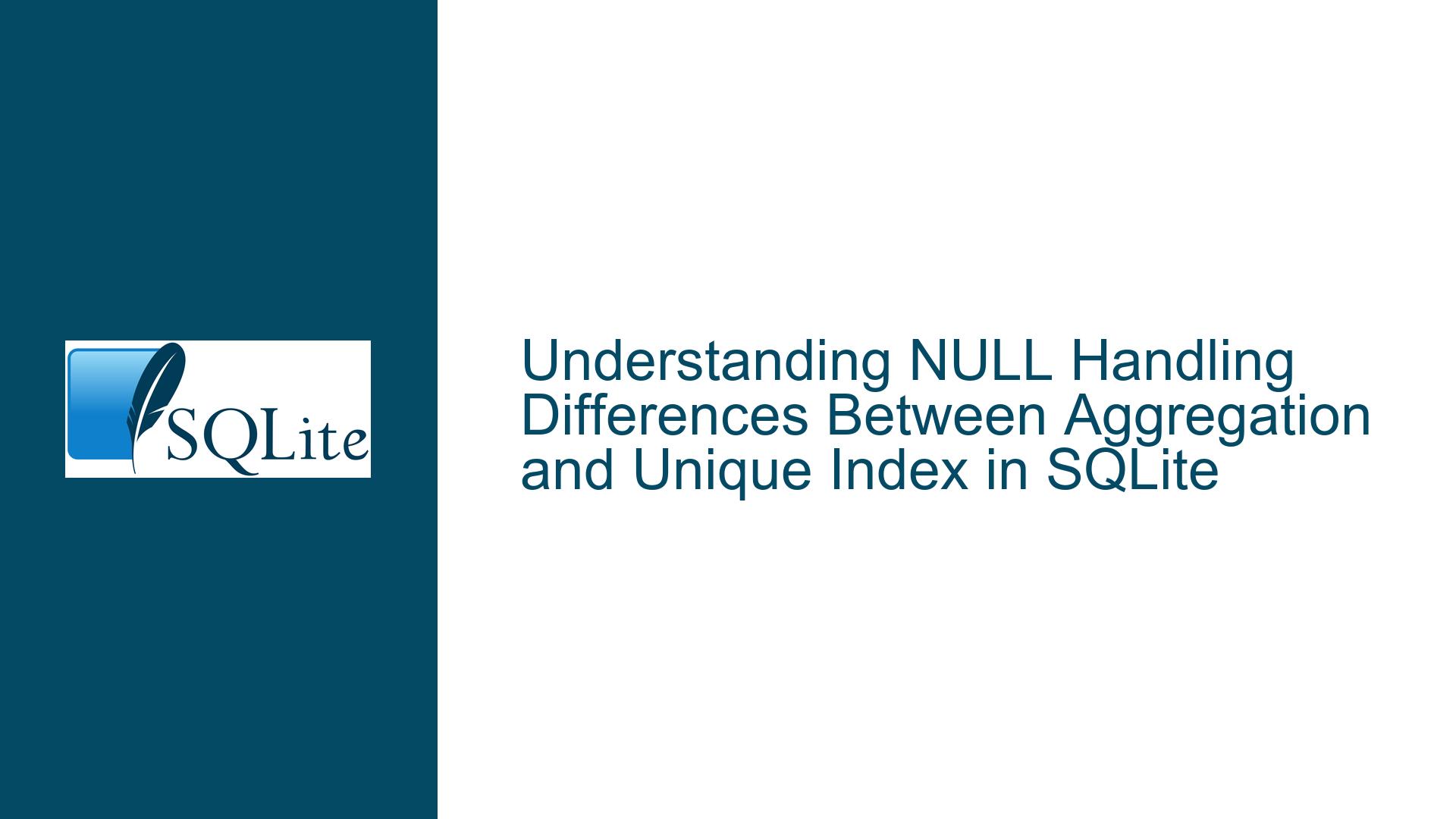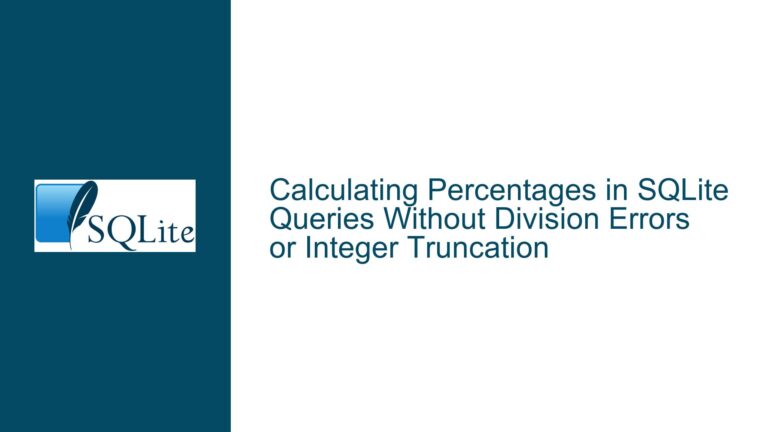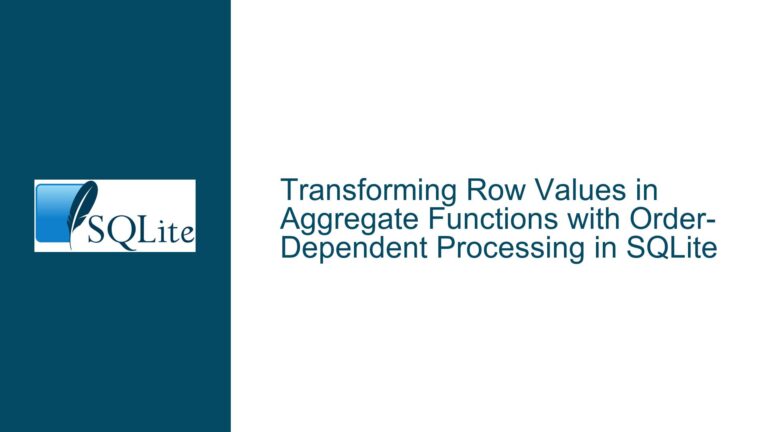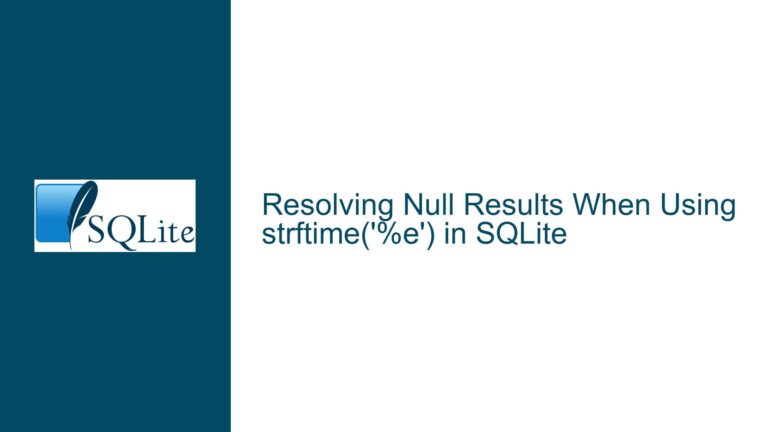NULL Handling Differences Between Aggregation and Unique Index in SQLite
Issue Overview: NULL Handling in Aggregation vs. Unique Index Creation
When working with SQLite, one of the most nuanced aspects of database design and query optimization revolves around how NULL values are handled in different contexts. Specifically, the behavior of NULLs in aggregation operations (such as GROUP BY) versus their treatment during the creation of a UNIQUE index can lead to subtle but significant differences in query results and database constraints. This discrepancy often catches developers off guard, especially when attempting to replace a UNIQUE index creation with a query that checks for duplicate rows using aggregation.
The core issue arises from the fact that SQLite treats NULL values as distinct from one another when creating a UNIQUE index. This means that multiple rows with NULL values in the indexed columns are considered unique, and the index creation will not fail. However, when using a GROUP BY clause in a query, SQLite treats NULLs as equal, meaning that rows with NULL values in the grouped columns will be aggregated together. This difference in NULL handling can lead to situations where a GROUP BY query indicates the presence of duplicates (by returning a count greater than 1), yet the UNIQUE index creation succeeds without any issues.
This behavior is particularly problematic when developers attempt to optimize their workflows by avoiding the disk I/O associated with index creation, especially when using in-memory temporary storage (temp_store). The assumption that a GROUP BY query can serve as a reliable pre-check for UNIQUE index creation is flawed due to the differing NULL handling mechanisms. As a result, developers may find themselves in a situation where their optimization attempts lead to unexpected outcomes, necessitating a deeper understanding of how SQLite handles NULLs in these contexts.
Possible Causes: Why NULL Handling Differs Between Aggregation and Unique Index
The root cause of this discrepancy lies in the fundamental design choices made by SQLite regarding how NULL values are interpreted in different operations. To understand why this happens, it’s essential to delve into the underlying mechanisms of both aggregation and unique index creation.
In SQLite, a UNIQUE index enforces the constraint that all indexed columns must contain unique combinations of values. However, when it comes to NULL values, SQLite adopts a specific interpretation: NULLs are considered distinct from one another. This means that if multiple rows have NULL values in the indexed columns, they are treated as unique, and the index creation will not fail. This behavior is consistent with the SQL standard, which specifies that NULLs are not equal to each other in the context of unique constraints.
On the other hand, when performing aggregation operations using GROUP BY, SQLite treats NULLs as equal. This means that rows with NULL values in the grouped columns will be aggregated together, leading to a single group for all NULL values. This behavior is also consistent with the SQL standard, which specifies that NULLs are considered equal in the context of grouping.
The difference in NULL handling between these two operations stems from their respective purposes. A UNIQUE index is designed to enforce data integrity by ensuring that no two rows have the same combination of values in the indexed columns. Treating NULLs as distinct allows for flexibility in data modeling, as it permits multiple rows with NULL values in the indexed columns without violating the unique constraint. In contrast, the purpose of GROUP BY is to aggregate rows based on the values in the specified columns, and treating NULLs as equal ensures that all rows with NULL values are grouped together, which is often the desired behavior for analytical queries.
This difference in NULL handling can lead to confusion when developers attempt to use a GROUP BY query as a pre-check for UNIQUE index creation. Since the GROUP BY operation treats NULLs as equal, it may indicate the presence of duplicates (by returning a count greater than 1) even when the UNIQUE index creation would succeed due to the distinct treatment of NULLs.
Troubleshooting Steps, Solutions & Fixes: Aligning Aggregation with Unique Index Behavior
To address the issue of differing NULL handling between aggregation and unique index creation, developers need to adopt strategies that align the behavior of their GROUP BY queries with that of UNIQUE index creation. This involves modifying the GROUP BY query to treat NULLs as distinct, similar to how they are treated in the context of a UNIQUE index. Below are detailed steps and solutions to achieve this alignment.
Step 1: Understanding the Role of rowid in SQLite
In SQLite, every row in a table has a unique identifier known as rowid. This identifier is automatically assigned by SQLite and is guaranteed to be unique within the table. The rowid can be leveraged to ensure that NULL values are treated as distinct in a GROUP BY query, effectively mimicking the behavior of a UNIQUE index.
Step 2: Modifying the GROUP BY Query to Treat NULLs as Distinct
To align the GROUP BY query with the behavior of a UNIQUE index, developers can use the coalesce function in combination with rowid. The coalesce function returns the first non-NULL value in its list of arguments. By using coalesce to replace NULL values with the rowid, developers can ensure that each NULL value is treated as distinct, as no two rows will have the same rowid.
For example, consider a table t with columns a, b, and c, where b is a nullable column. To check for duplicates in the combination of a, b, and c, the following query can be used:
SELECT EXISTS (
SELECT 1
FROM t
GROUP BY a, coalesce(b, rowid), c
HAVING COUNT(*) > 1
);
In this query, the coalesce(b, rowid) function ensures that any NULL values in column b are replaced with the rowid, making them distinct. This modification aligns the GROUP BY query with the behavior of a UNIQUE index, ensuring that the query returns 1 (indicating duplicates) only if the UNIQUE index creation would fail.
Step 3: Comparing Row Counts to Validate Unique Index Creation
Another approach to validating the success of a UNIQUE index creation is to compare the total number of rows in the table with the number of distinct combinations of the indexed columns. This method involves two queries: one to count the total number of rows and another to count the number of distinct combinations of the indexed columns, with NULLs treated as distinct using coalesce and rowid.
For example, consider the same table t with columns a, b, and c. The following queries can be used to compare the row counts:
-- Query 1: Count the total number of rows in the table
SELECT COUNT(*) FROM t;
-- Query 2: Count the number of distinct combinations of a, b, and c, with NULLs treated as distinct
SELECT COUNT(*) FROM (
SELECT DISTINCT a, coalesce(b, rowid), c FROM t
);
If the counts returned by these two queries are equal, it indicates that all combinations of a, b, and c are unique, and the UNIQUE index creation will succeed. If the counts differ, it indicates the presence of duplicates, and the UNIQUE index creation will fail.
Step 4: Implementing the Solution in Practice
To implement the solution in practice, developers should follow these steps:
- Identify the columns that will be included in the
UNIQUEindex. - Determine which of these columns are nullable.
- Modify the
GROUP BYquery to usecoalescewithrowidfor each nullable column, ensuring that NULLs are treated as distinct. - Execute the modified
GROUP BYquery to check for duplicates. - If the query returns
0(indicating no duplicates), proceed with theUNIQUEindex creation. - If the query returns
1(indicating duplicates), handle the duplicates appropriately before attempting to create theUNIQUEindex.
Step 5: Handling Edge Cases and Performance Considerations
While the use of coalesce and rowid effectively aligns the GROUP BY query with the behavior of a UNIQUE index, developers should be aware of potential edge cases and performance considerations.
One edge case to consider is the possibility of rowid collisions when using coalesce with rowid. Although rowid is guaranteed to be unique within a table, it is theoretically possible for two different rows to have the same rowid if the table has been subjected to certain operations (e.g., VACUUM). To mitigate this risk, developers can use a combination of rowid and a unique identifier (e.g., a timestamp or a random value) to ensure that NULL values are treated as distinct.
In terms of performance, the modified GROUP BY query may be more computationally expensive than the original query, especially for large tables. This is because the query must perform additional operations to replace NULL values with rowid and then group the rows accordingly. Developers should consider the performance implications of this approach and optimize the query as needed, such as by adding appropriate indexes or limiting the scope of the query to a subset of the table.
Step 6: Alternative Approaches to Handling NULLs in Unique Indexes
In some cases, developers may prefer to handle NULLs differently when creating a UNIQUE index. For example, they may want to treat NULLs as equal, similar to how they are treated in a GROUP BY query. This can be achieved by using a partial index, which includes only the rows where the indexed columns are not NULL.
For example, consider a table t with columns a, b, and c, where b is a nullable column. To create a UNIQUE index that treats NULLs as equal, the following partial index can be used:
CREATE UNIQUE INDEX tmp_unique_index ON t(a, b, c) WHERE b IS NOT NULL;
This index will enforce uniqueness only for rows where b is not NULL, effectively treating NULLs as equal. However, this approach has limitations, as it does not enforce uniqueness for rows where b is NULL. Developers should carefully consider the implications of this approach and choose the one that best fits their specific use case.
Conclusion
The subtle differences in NULL handling between aggregation and unique index creation in SQLite can lead to unexpected outcomes, particularly when developers attempt to use GROUP BY queries as a pre-check for UNIQUE index creation. By understanding the underlying mechanisms of NULL handling and adopting strategies to align the behavior of GROUP BY queries with that of UNIQUE indexes, developers can avoid these pitfalls and ensure the integrity of their database constraints.
The use of coalesce with rowid is a powerful technique for treating NULLs as distinct in GROUP BY queries, effectively mimicking the behavior of a UNIQUE index. Additionally, comparing row counts and using partial indexes are alternative approaches that can be employed depending on the specific requirements of the use case.
Ultimately, the key to successfully navigating these nuances lies in a deep understanding of SQLite’s NULL handling mechanisms and the ability to apply this knowledge to real-world scenarios. By following the detailed steps and solutions outlined in this guide, developers can confidently optimize their workflows and ensure the reliability of their database constraints.






